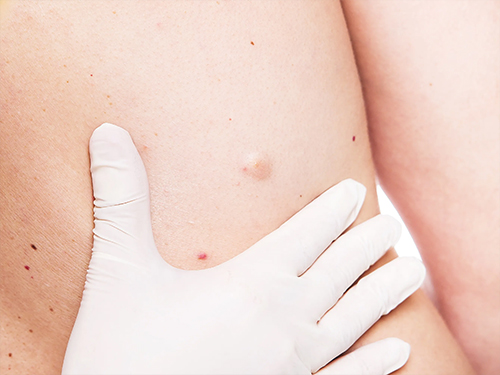Cyst Removal
An epidermoid cyst is a non cancerous (benign) lump that is a result of occluded pilosebaceous unit. Epidermoid cysts are slow growing and often painless, so they rarely cause problems or need treatment. Patients might choose to have a cyst removed if its appearance bothers them or if it’s painful, ruptured, or infected.

Cyst removal SURGERY – FACTS
| Length of surgery | 30-60 minutes |
| Anaesthesia | General or local anaesthetic |
| Hospital stay | Day case |
| Risks/complications of surgery | Frequent: Swelling, bruising |
| Recovery | 5-7 days facial sutures removed if used |
| Driving | Usually can drive same day |
| Follow up | 6 weeks |
| Duration of results | Permanent unless recurrence |
DOWNLOAD FURTHER INFORMATION
Cyst Removal
Any plastic surgery procedure is a very personal choice and understandably there are a number of questions that arise. This information sheet is a general guide for patients considering malignant melanoma treatment under the care of Dr Mackenzie. It should provide the answers to some questions that you may have.
What is an epidermoid cyst?
An epidermal inclusion cyst is the most common cutaneous cyst. Epidermal inclusion cysts are also known as epidermal cysts, epidermoid cysts, pilar cysts, infundibular cysts, and keratin cysts.
Epidermal inclusion cysts are formed from the follicular infundibulum, which is part of the hair follicle. Epidermal inclusion cysts form when the follicular infundibulum is disrupted, or when the surface of the skin becomes implanted below the skin through an injury or trauma in the area, such as a scratch, surgical wound, or a skin condition like acne.
Many people refer to epidermoid cysts as sebaceous cysts, but they’re different. True sebaceous cysts are less common. They arise from the glands that secrete oily matter that lubricates hair and skin (sebaceous glands).
They can be located anywhere, but are most common on the face, followed by the chest or back, scalp, neck, legs, arms and/or genitalia. They are not contagious.
Epidermoid inclusion cysts are typically harmless, but rarely can become malignant (cancerous). Approximately 1% have been shown to transform into malignancy.
Beware of cysts that have been present from birth, or which arose in the first few years of life as they could represent dermoid cysts. These arise in lines of fusion and are most seen on the head and neck (particularly around the eyes, in the midline or on the scalp). Dermoid cysts can have deep connections, sometimes intra-cranially, and so if need to be removed the patient must be referred to an appropriate specialist.
What are the features of an epidermoid cyst?
The clinical features of epidermoid cyst include:
- are round lumps just underneath the skin
- they are often firm and fixed to the overlying skin
- can be mobile
- often contain fluid or pus (cheesy debris can be expressed from the central punctum)
- sometimes have a small, dark spot in the middle
- grow slowly and vary in size from smaller than a pea to several centimetres across
- can get sore or red if they get infected – the redness may be harder to see on black or brown skin
What gets epidermoid inclusion cysts?
Although they can appear at any age, epidermal inclusion cysts most frequently occur during early to mid-adulthood (ages 20-60s). Epidermal inclusion cysts rarely appear before puberty. They are one and a half times more common in males than in females. Some genetic disorders may increase the risk of developing multiple epidermoid cysts (Gorlin Syndrome, Gardner Syndrome).
How is an epidermoid cyst diagnosed?
Usually, the healthcare provider can diagnose an epidermal inclusion cyst with a simple examination of the skin. Biopsy is usually not needed, and the cyst can be removed for both cosmetic reasons, patient’s choice or due to complications such as recurrent infections or inflammations. In very rare cases, epidermoid cysts can lead to skin cancer.
How are the epidermoid cysts treated?
In many cases, epidermal inclusion cysts can be left untreated and monitored, as they are not dangerous, and especially if they are not causing any symptoms. Do not try to burst and drain the cyst yourself, as it could cause and/or spread an infection, and the cyst will likely grow back.
A treatment can be recommended if you experience:
• infected skin cyst-antibiotics maybe prescribed, or it may need to be incised and drained
• large and painful cyst that effects everyday life may be surgically removed
• if it’s not causing any problems but is on a visible part of your body, such as on your face, patient may choose to have it removed.
Surgical excision (minimal excision technique) is the most effective treatment for an epidermoid cyst. Usually, a local anaesthetic is used to numb the area around the cyst before it is excised via a small incision if possible.
It may be difficult to achieve a complete removal following a cyst rupture. The excision usually leaves a small scar.